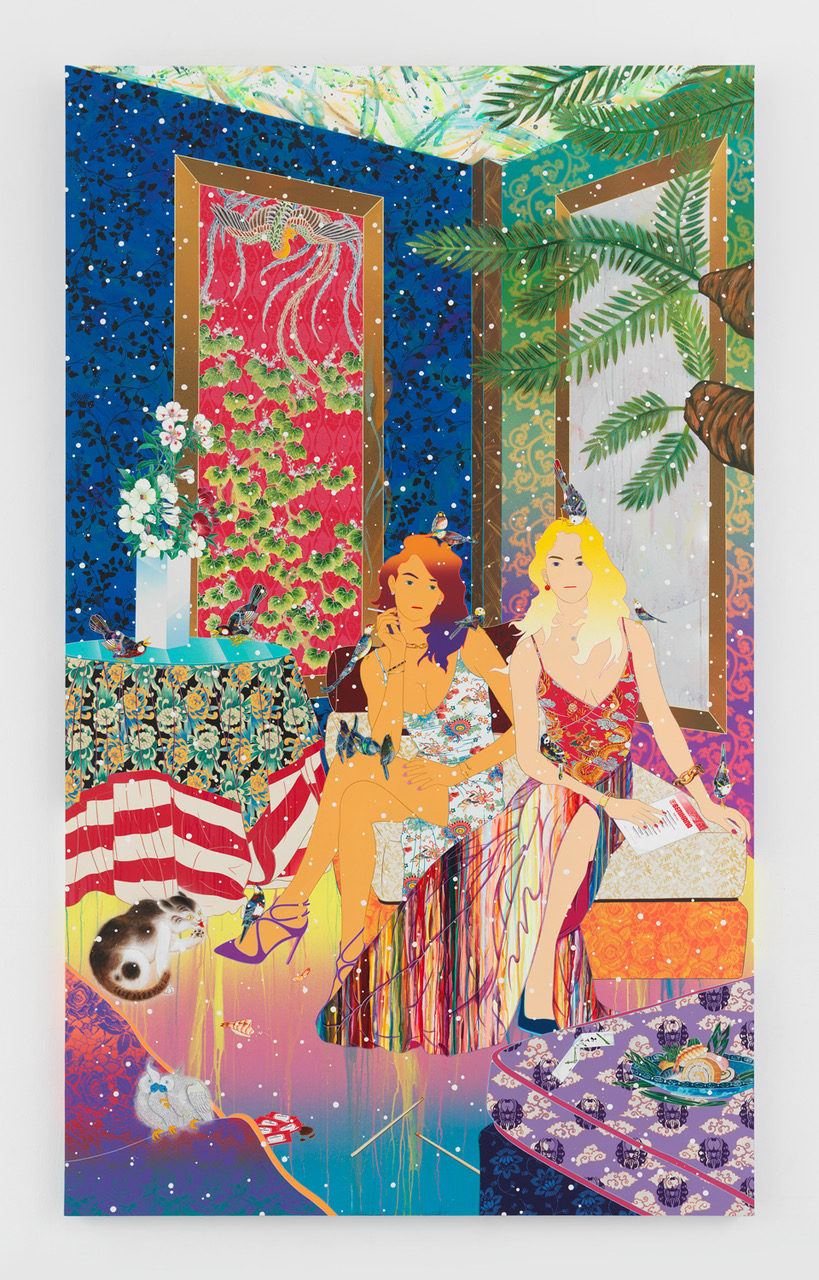-
Artworks
Tomokazu Matsuyama Japan, b. 1976
Turn Up the Happy Hour, 2021Acrylic and mixed media on canvas100 x 60 x 2 in
254 x 152.4 x 5.1 cm8067Further images
This painting by Tomokazu Matsuyama incorporates a menagerie of Eastern and Western influences, embodying Matsuyama’s interest in intercultural exchange. The two figures are seated inside a bedroom. One holds a...This painting by Tomokazu Matsuyama incorporates a menagerie of Eastern and Western influences, embodying Matsuyama’s interest in intercultural exchange. The two figures are seated inside a bedroom. One holds a takeout menu from Benihana. Scattered throughout the scene are the remnant of a takeout meal: partially eaten sushi, chopsticks, and open soy sauce packets. The four mattresses in the scene are bare, and each decorated with a distinct pattern. Though it is an interior space, flowers, a tree, and a range of wildlife fill the scene. One of the figures is smoking a cigarette. Both figures have birds perched atop their heads. The juxtaposition of different references creates a space where the visual and cultural traditions of the East and West come together, inviting any viewer to enter the scene and construct an individualized narrative.
Amalgamated from his vast mental and physical archive of iconographical material, Matsuyama’s painted worlds vivify his lived experience. His fresh approach to the language of figuration creates dual references to both our contemporary realities and our multiplicitous pasts, combining allusions to fashion models torn from the pages of glossy magazines; flora and fauna borrowed from Edo-period folding screens; open-source wallpaper patterns from the Internet; fragmented snippets of pop culture and celebrity life; frozen movements captured from the garments of centuries-old Buddhist sculptures; compositional strategies of the European Renaissance masters; aesthetic cues from Modernist art history such as shaped canvases and Abstract Expressionist techniques; and of course, those innumerable bits of branded trash ubiquitous on the streets of every city in the Western world.
Matsuyama’s carefully constructed, fictional landscapes welcome anyone inside to build their own narrative and discover their own meaning. What name should we give this aesthetic, which relates to nobody nowhere, yet is recognized by everyone everywhere?
“I call it the global us,” Matsuyama says.
This is Matsuyama’s mastery as an artist; by questioning what is familiar and what is foreign, he shows us pictures of others that are also reflections of ourselves.
“Adaptation is my life,” Matsuyama says. “In Japan, I was brought up in Hida-Takayama City, a mountain area, a small, traditional place. Then in the mid-80s, I moved to Los Angeles. Surfing and skateboarding and young, fresh American culture were totally shocking to see. Then I came back to Tokyo and attended boarding school, where the atmosphere was of one mood, one way of thinking. Then when I moved to New York, the first thing I noticed was the mess, the chaos. Unlike Japan, garbage was everywhere. That was something I had never seen before.”
Curiosity is essential to Matsuyama’s practice, as he invites us into an ever-evolving, global cultural conversation across a complex web of memories, visual languages, histories, dreams, and expectations.
“My visual language is a community-based language,” Matsuyama says. “My paintings are not intended to inform viewers of specific messages nor narratives. These little fractions of everyday culture remind the viewers of narratives in their own life. That leads to ownership. It represents them. It represents me. It represents us. What’s the best part? It’s subjective.”1of 2





